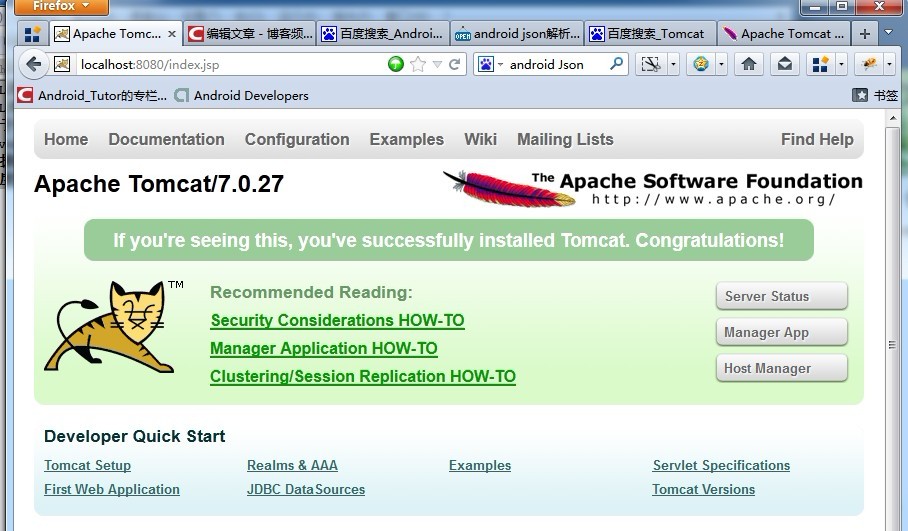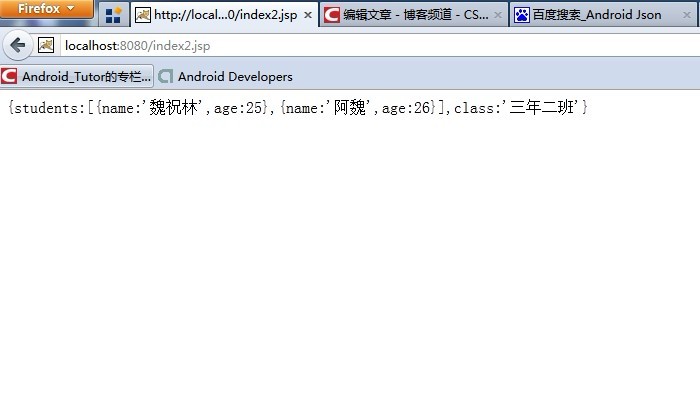大家好,今天给大家分享下Android解析Json的例子,我这里自己安装了Tomcat,让自己电脑充当下服务器,最重要的是,返回结果自己可以随便修改。
首先看下Json的定义,以及它和XML的比较:
JSON的定义:
一种轻量级的数据交换格式,具有良好的可读和便于快速编写的特性。业内主流技术为其提供了完整的解决方案(有点类似于正则表达式 ,获得了当今大部分语言的支持),从而可以在不同平台间进行数据交换。JSON采用兼容性很高的文本格式,同时也具备类似于C语言体系的行为。 – Json.org
JSON Vs XML
1.JSON和XML的数据可读性基本相同
2.JSON和XML同样拥有丰富的解析手段
3.JSON相对于XML来讲,数据的体积小
4.JSON与JavaScript的交互更加方便
5.JSON对数据的描述性比XML较差
6.JSON的速度要远远快于XML.
Tomcat安装:
Tomcat下载地址http://tomcat.apache.org/下载后安装,如果成功,启动Tomcat,然后在浏览器里输入:http://localhost:8080/index.jsp,会有个Tomcat首页界面,

我们在Tomcat安装目录下webapps\ROOT下找到index.jsp,然后新建一个index2.jsp,用记事本或者什么的,编辑内容如下:
{students:[{name:'魏祝林',age:25},{name:'阿魏',age:26}],class:'三年二班'}然后我们在浏览器里输入:http://localhost:8080/index2.jsp返回的结果如下(这就模拟出后台返回的数据了):

新建一个Android工程JsonDemo.
工程目录如下:

这里我封装了一个JSONUtil工具类,代码如下:
packagecom.tutor.jsondemo; importjava.io.IOException; importjava.io.InputStreamReader; importjava.io.UnsupportedEncodingException; importorg.apache.http.HttpEntity; importorg.apache.http.HttpResponse; importorg.apache.http.client.methods.HttpGet; importorg.apache.http.impl.client.DefaultHttpClient; importorg.apache.http.params.BasicHttpParams; importorg.apache.http.protocol.HTTP; importorg.json.JSONException; importorg.json.JSONObject; importandroid.util.Log; /*** @authorfrankiewei. * Json封装的工具类. */ public classJSONUtil { private static final String TAG = "JSONUtil"; /*** 获取json内容 * @paramurl * @returnJSONArray * @throwsJSONException * @throwsConnectionException */ public static JSONObject getJSON(String url) throwsJSONException, Exception { return newJSONObject(getRequest(url)); } /*** 向api发送get请求,返回从后台取得的信息。 * * @paramurl * @returnString */ protected static String getRequest(String url) throwsException { return getRequest(url, new DefaultHttpClient(newBasicHttpParams())); } /*** 向api发送get请求,返回从后台取得的信息。 * * @paramurl * @paramclient * @returnString */ protected static String getRequest(String url, DefaultHttpClient client) throwsException { String result = null; int statusCode = 0; HttpGet getMethod = newHttpGet(url); Log.d(TAG, "do the getRequest,url="+url+""); try{ //getMethod.setHeader("User-Agent", USER_AGENT); HttpResponse httpResponse =client.execute(getMethod); //statusCode == 200 正常 statusCode =httpResponse.getStatusLine().getStatusCode(); Log.d(TAG, "statuscode = "+statusCode); //处理返回的httpResponse信息 result =retrieveInputStream(httpResponse.getEntity()); } catch(Exception e) { Log.e(TAG, e.getMessage()); throw newException(e); } finally{ getMethod.abort(); } returnresult; } /*** 处理httpResponse信息,返回String * * @paramhttpEntity * @returnString */ protected staticString retrieveInputStream(HttpEntity httpEntity) { int length = (int) httpEntity.getContentLength(); //the number of bytes of the content, or a negative number if unknown. If the content length is known but exceeds Long.MAX_VALUE, a negative number is returned. //length==-1,下面这句报错,println needs a message if (length < 0) length = 10000; StringBuffer stringBuffer = newStringBuffer(length); try{ InputStreamReader inputStreamReader = newInputStreamReader(httpEntity.getContent(), HTTP.UTF_8); char buffer[] = new char[length]; intcount; while ((count = inputStreamReader.read(buffer, 0, length - 1)) > 0) { stringBuffer.append(buffer, 0, count); } } catch(UnsupportedEncodingException e) { Log.e(TAG, e.getMessage()); } catch(IllegalStateException e) { Log.e(TAG, e.getMessage()); } catch(IOException e) { Log.e(TAG, e.getMessage()); } returnstringBuffer.toString(); } }
编写主Activity代码JSONDemoActivity,代码如下:
packagecom.tutor.jsondemo; importorg.json.JSONArray; importorg.json.JSONException; importorg.json.JSONObject; importandroid.app.Activity; importandroid.os.Bundle; importandroid.widget.TextView; public class JSONDemoActivity extendsActivity { /*** 访问的后台地址,这里访问本地的不能用127.0.0.1应该用10.0.2.2 */ private static final String BASE_URL = "http://10.0.2.2:8080/index2.jsp"; privateTextView mStudentTextView; privateTextView mClassTextView; @Override public voidonCreate(Bundle savedInstanceState) { super.onCreate(savedInstanceState); setContentView(R.layout.main); setupViews(); } /*** 初始化 */ private voidsetupViews(){ mStudentTextView =(TextView)findViewById(R.id.student); mClassTextView =(TextView)findViewById(R.id.classes); try{ //获取后台返回的Json对象 JSONObject mJsonObject =JSONUtil.getJSON(BASE_URL); //获得学生数组 JSONArray mJsonArray = mJsonObject.getJSONArray("students"); //获取第一个学生 JSONObject firstStudent = mJsonArray.getJSONObject(0); //获取班级 String classes = mJsonObject.getString("class"); String studentInfo = classes + "共有 " + mJsonArray.length() + " 个学生." + "第一个学生姓名: " + firstStudent.getString("name") + " 年龄: " + firstStudent.getInt("age"); mStudentTextView.setText(studentInfo); mClassTextView.setText("班级: " +classes); } catch(JSONException e) { e.printStackTrace(); } catch(Exception e) { e.printStackTrace(); } } }
这里用到的布局文件main.xml代码如下:
<?xml version="1.0" encoding="utf-8"?> <LinearLayout xmlns:android="http://schemas.android.com/apk/res/android"android:layout_width="fill_parent"android:layout_height="fill_parent"android:orientation="vertical" > <TextView android:id="@+id/student"android:layout_width="fill_parent"android:layout_height="wrap_content"android:text="@string/hello" /> <TextView android:id="@+id/classes"android:layout_width="fill_parent"android:layout_height="wrap_content" /> </LinearLayout>
最后要在AndroidMainfest.xml中添加访问网络权限:
<?xml version="1.0" encoding="utf-8"?> <manifest xmlns:android="http://schemas.android.com/apk/res/android"package="com.tutor.jsondemo"android:versionCode="1"android:versionName="1.0" > <uses-permission android:name="android.permission.INTERNET"></uses-permission> <application android:icon="@drawable/ic_launcher"android:label="@string/app_name" > <activity android:name=".JSONDemoActivity"android:label="@string/app_name" > <intent-filter> <action android:name="android.intent.action.MAIN" /> <category android:name="android.intent.category.LAUNCHER" /> </intent-filter> </activity> </application> </manifest>
运行工程,效果如下:

转:http://blog.csdn.net/android_tutor/article/details/7466620